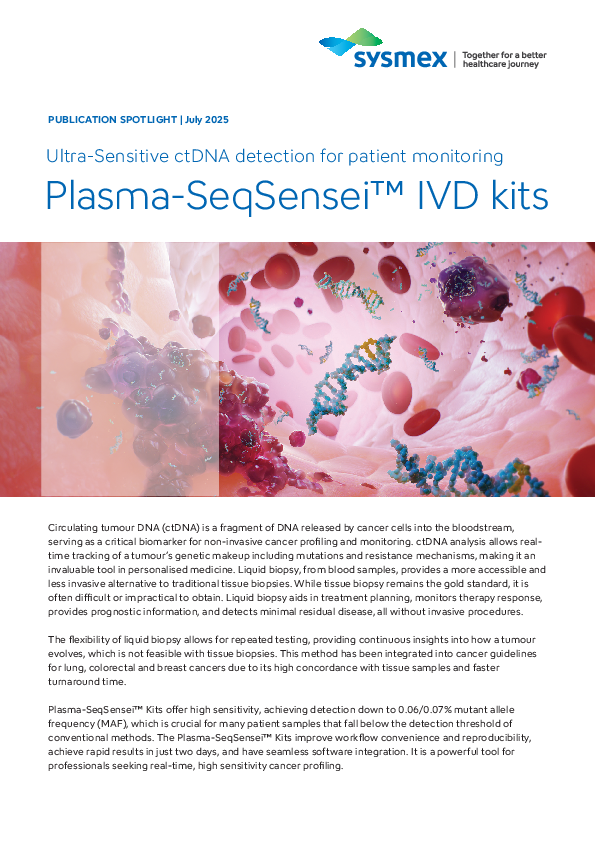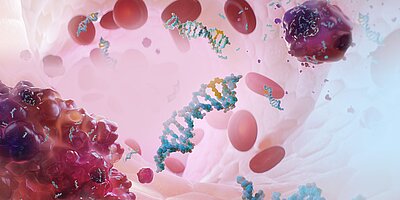Liquid biopsy impact: integration of liquid biopsy into routine oncology practice
From emerging evidence to standard-of-care applications across Europe

In recent Impact conversations, we explored the latest advancements in liquid biopsy, including highlights from leading scientific conferences, clinical trials, and peer-reviewed publications. While these developments are promising, the real objective is clear: to translate innovation into clinical routine, ensuring patients benefit from the most current standards of care.
Across Europe, we are seeing encouraging momentum. Reimbursement updates in several countries now more closely align with clinical guidelines, paving the way for broader adoption of liquid biopsy. Meanwhile, revisions to the ESCAT score6 have reinforced the clinical relevance of specific gene targets, bringing liquid biopsy closer to standard practice.
At the X Symposium on Liquid Biopsy in Santiago de Compostela, several real-world applications were presented. One group from the Bellvitge Biomedical Research Institute, in collaboration with the Institut Català d'Oncologia3, presented a poster detailing their use of liquid biopsy to identify actionable mutations in breast cancer patients. In their study of 48 patients, they detected PIK3CA mutations in 47% and ESR1 mutations in 37%, concluding that 48% of the cohort could have been directed to targeted therapies thanks to ultra-sensitive molecular profiling.
Another highlight from the symposium, Dr Sandra Pérez Buira gave an oral presentation4 on the predictive and clinical utility of highly sensitive ctDNA-based NGS in patients with metastatic luminal breast cancer. At Fundación Jiménez Díaz, 68% of patients assessed for ESR1 mutations had mutant allele frequencies (MAFs) below 1%. She also presented data from the FLIPPER clinical trial8, which not only tracked targetable mutations but also followed 187 patients at baseline, across four time points, and at disease progression. Preliminary results presented at ASCO 2024 showed that patients with two or more baseline mutations were significantly more likely to experience rapid progression (≤12 months), a poorer objective response, and worse progression-free and overall survival. These findings demonstrate the prognostic potential of ctDNA beyond treatment selection, offering tools for risk stratification.
In a similar effort to define clinical standards, Professor Geert Martens and the AZ Delta lab proposed a ctDNA-based patient monitoring model7. Patients, with fewer than ten mutant molecules, were considered in a “safe zone” with an 83% negative predictive value (NPV) for disease progression within 12 weeks. Those with over 100 mutant molecules were in a “danger zone”, with a 91% positive predictive value (PPV) for progression. This model builds on their prior work in non-small cell lung cancer (NSCLC)1 and brings measurable structure to surveillance strategies using liquid biopsy.
Beyond data and models, the field is also advancing towards operational clarity. A mini-review by Gamish et al.2 offers practical guidance on implementing the ESMO recommendations for routine use of ctDNA, addressing key issues such as target selection, optimal time points, analytical considerations, and the interpretation of CHIP-related mutations. Furthermore, the European Liquid Biopsy Society (ELBS) recently published a consensus on reporting standards for cfDNA molecular testing5. These guidelines acknowledge the distinct interpretive challenges of liquid biopsy versus tissue testing and provide structured approaches: for instance, advising that low-yield samples be labelled “equivocal” rather than “negative”, that CHIP mutations be clearly flagged, and that reports highlight but do not prescribe treatment options — keeping clinical decisions in the hands of treating teams.
Together, these developments signal a pivotal shift: liquid biopsy is no longer an emerging technology — it is steadily becoming a cornerstone of precision oncology. With policy updates, predictive algorithms and standardized reporting frameworks, the tools for integration are now in place. The remaining challenge lies not in technological feasibility, but in achieving widespread clinical adoption, advancing education, and fostering collaboration to make liquid biopsy a routine part of cancer care.
Want to learn more about how Plasma-SeqSensei supports ultra-sensitive mutation detection in routine oncology?
Read our latest Publication Spotlight highlighting its clinical utility and performance in real-world settings — even at the lowest allele frequencies.

Circulating tumour DNA (ctDNA) is a fragment of DNA released by cancer cells into the bloodstream, serving as a critical biomarker for non-invasive cancer profiling and monitoring. ctDNA analysis allows realtime tracking of a tumour’s genetic makeup including mutations and resistance mechanisms, making it an invaluable tool in personalised medicine.
References
[1] Claus, J., De Smet, D., Breyne, J., Wesolowski, J., Himpe, U., Demedts, I. and Martens, G.A. (2024): Patient-centric thresholding of Cobas® EGFR mutation Test v2 for surveillance of EGFR-mutated metastatic non-small cell lung cancer. Scientific Reports, 14(1), p.18191.
[2] Gamisch, A., Mustafa, H.G., Haushofer, A. and Mustafa-Korninger, M.E. (2024): Implementing the ESMO recommendations for the use of circulating tumor DNA (ctDNA) assays in routine clinical application/diagnostics. Journal of Laboratory Medicine, 48(4), pp.141-151.
[3] Bauto, A. G., Falo, C., Azuara, D., Gonzalez, S., Cruz, J. S., Vethencourt, A., Fullana, B., Fernandez, A., Gil-Gil, M., Sabat, P., Vazquez, S., Ejarque, C., Recalde, S., Obadia, V., Villanueva, R., Pernas, S., Lazaro, C. (2025): Liquid biopsy as a tool for identifying actionable mutations in metastatic breast cancer: Insights from a clinical cohort. X Liquid Biopsy Symposium
[4] Buira, S. (2025): Predictive and clinical utility of highly sensitive ctDNA-based NGS in metastatic luminal breast cancer patients. Experiences with Plasma-SeqSensei Breast Cancer assay. X Liquid Biopsy Symposium
[5] de Jager, V.D., Giacomini, P., Fairley, J.A., Toledo, R.A., Patton, S.J., Joosse, S.A., Koch, C., Deans, Z.C., Agelaki, S., Andersen, C.L. and Andersson, D. (2025): Reporting of molecular test results from cell-free DNA analyses: expert consensus recommendations from the 2023 European Liquid Biopsy Society ctDNA Workshop. EBioMedicine, 114.
[6] Mosele, M.F., Westphalen, C.B., Stenzinger, A., Barlesi, F., Bayle, A., Bièche, I., Bonastre, J., Castro, E., Dienstmann, R., Krämer, A. and Czarnecka, A.M. (2024): Recommendations for the use of next-generation sequencing (NGS) for patients with advanced cancer in 2024: a report from the ESMO Precision Medicine Working Group. Annals of Oncology, 35(7), pp.588-606.
[7] Martens, G.A., Demol, J., Dedeurwaerdere, F., De Smet, K., Wesolowski, J. and De Smet, D. (2025): Surveillance of disease progression in metastatic breast cancer by molecular counting of circulating tumor DNA using Plasma-SeqSensei Breast Cancer in vitro diagnostics assay. The Journal of Molecular Diagnostics, 27(1), pp.25-35.
[8] Rojo Todo, F.G., Meier, L., Martínez, M.T., Esteban López, M., Paris, L., O'Connor, M., De la Cruz Merino, L., Santaballa, A., Martinez-Jañez, N., Moreno Antón, F. and Fernández, I. (2024): Plasma mutational burden in PIK3CA and TP53 independently predicts early progression in patients with HR+/HER2-metastatic breast cancer (MBC) enrolled in the GEICAM/2014-12 FLIPPER trial.


